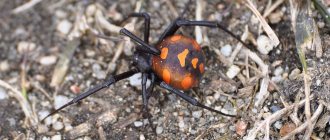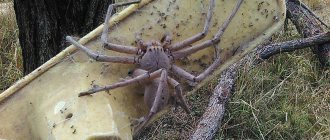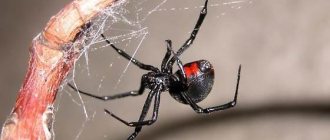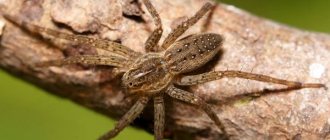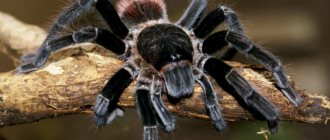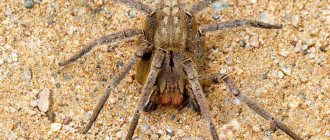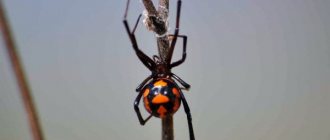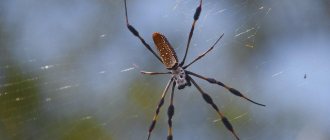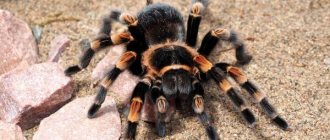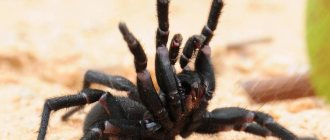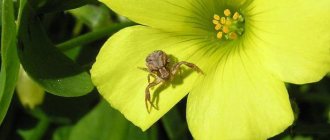Description of appearance - general features
Hunting spiders live on almost all continents and differ in size, color, lifestyle, and reproduction. The most famous 3 species are inhabitants of tropical countries.
Australian hunter spider (lat. Heteropoda)
The leg span is 30 cm, body length is 46 mm. The largest spider in Australia. The color is varied. Brown, gray, green shades predominate. Females are always almost 2 times larger than males. The abdomen is convex, 4 pairs of powerful, long limbs are attached to the cephalothorax. There are 8 eyes on the head, 2 of which are main, the rest are auxiliary.
On a note!
The Australian giant spider is nocturnal and hunts from ambush or stalks prey. It does not weave trapping nets, but it envelops the entrance to its own shelter with a web. An adult lives up to 3 years.
Border spider hunter
Representative of the Eurasian continent. The body size of the female is 2 cm, the male is 1.3 cm. The color is yellow-brown, black-brown. There are bright yellow stripes on the sides. In young spiders, the body is uniformly yellow, with no stripes or spots. Settles along the banks of reservoirs in moist soil. It does not form trapping nets. Hunts aquatic and land insects, fish, fry, frogs. Runs fast and dives.
On a note!
The lifespan of sexually mature females is 1.5 years. Males die much earlier - almost immediately after fertilization; very often they are eaten by the female.
Huntsman spiders
Striped spider hunter
It lives in European countries; the spider is found in Russia. In total, about 1 thousand varieties are known. It is distinguished by its bright color and large size. The body length of females reaches 2 cm excluding legs, males are half that size. The cephalothorax is brown, and there are longitudinal yellow stripes on the abdomen. Limbs 6 cm long are covered with hairs and spines. A photo of a hunter's spider with a bright color is presented below. It hunts from ambush and settles near water bodies. Runs fast and builds a raft from plants to move through water. The female lives up to 2 years.
Interesting!
Due to their large size and bright color, hunting spiders are often kept as pets. In an artificial environment they grow, mate, and reproduce.
Spiders are less dangerous than bees
Spiders are the most widespread venomous creatures in Australia, with approximately 10,000 different species found in a wide variety of ecosystems. But although spiders live among us everywhere, spider bites are very rare. In fact, spiders are less dangerous to life than snakes, sharks or even bees.
"More deaths are occurring from allergic reactions to bees," says Dr Geoff Isbister, a poisoning researcher at the University of Newcastle. He also notes the extent of our irrational fear of spiders: “If we all get into our cars perfectly calmly (about 1,000 people die every year in car accidents), then we have absolutely no need to fear spiders.”
Antivenin (anti-venom serum) for two of the most dangerous spiders - the Sydney funnel web spider and the red back spider - has been available since the 1950s and 1981, respectively. These antivenins are used only in really serious cases, which, however, rarely occurs in life.
Spider venom is a cocktail of chemical compounds, some of which can be toxic to humans, but this venom is not intended for humans. Their venom is designed for hunting small prey and is released in small quantities, which can often be fatal for tiny creatures, while larger organisms cope with it successfully. When injected into a horse, for example, spider venom triggers an immune response in the animal, and antibodies begin to be produced that neutralize the toxins.
Behavior, lifestyle
All hunters live near bodies of water; they are often caught together with duckweed with a net or seine. They live on the water or in close proximity. They do not weave trapping nets to catch prey; they hunt actively. Once on the water, they quickly form a raft from available materials - dry grass, leaves, bark. They entangle several parts with a web, sit on a raft, calmly swim through a swamp, a deep puddle.
Striped spider hunter
The main diet is insects. And also fry, crustaceans, snails, caterpillars. Large specimens prey on fish, frogs, newts, snakes, and snakes. They attack from a secluded place. They inject poison and saliva. The first substance paralyzes the victim, the second liquefies the insides into a broth. After a few minutes, the predator starts eating.
They gather in pairs only during the mating season. After fertilization, a hungry female can safely eat her “suitor.” To lay eggs, it forms a cocoon of spider webs. It can hold from 500 to 1000 pieces at a time. The female attaches them to plants near the pond or carries them on herself. The incubation period is 3 weeks. Young spiders almost immediately begin to live independently.
Who lives in the water and how to go to the beach without getting eaten
News of shark attacks on people in Australia reaches even our latitudes. However, attacks are extremely rare. In 2022, there were only 11 unprovoked shark attacks on humans off the coast of Australia, but none resulted in death. “Unprovoked bites” is the standard wording used when talking about attack statistics for this predator. If a person himself provoked the shark (for example, he tried to feed it) and it attacked, this case is not taken into account. Accidental provocation, when a person swam further than the permitted swimming zone, is taken into account in the general statistics.
For comparison: in the United States last year, 41 attacks were recorded, and all of them were alive. Three quarters of all shark attacks on people occur against surfers (61%), divers (11%) and scuba divers (3%). If you are not at risk and are just swimming, a shark will not attack you.
Sharks do not hunt humans, but prefer fattier and less bony prey: seals or fish. And, despite our stereotypes, they try to stay away from crowded beaches. Meeting a crowd of noisy and screaming people in the water is quite scary for the sharks themselves. Most attacks on surfers occur because sharks mistake the surf for a seal. But you need to understand that surfers are quite risky guys and often swim on those beaches where swimming is not recommended.
Danger to humans
Hunters are nocturnal and can crawl into a person’s house in search of food. They hide under furniture, in shoes, among clothes, in cabinets with dishes.
On a note!
Swelling, swelling, and redness occur at the site of the spider bite. People with weak immune systems, allergy sufferers, and young children often experience a deterioration in their health - weakness, dizziness, headache, nausea, diarrhea, vomiting. The condition returns to normal in a few days. To speed up the effect, take antihistamines. The hunter is not one of the deadly poisonous spiders.
What to do if bitten by a snake
But, no matter how poisonous snakes are, they are afraid of humans. They sense vibrations in the ground, so they crawl away when people approach. There is not a single snake in Australia that is interested in humans as prey. And, unlike people, animals do not kill unnecessarily. Therefore, trying to scare away a person, the snake sometimes makes dry bites without injecting poison - it needs poison primarily for hunting. They sting only for the purpose of self-defense, when someone tries to grab them by the tail (this happens) or accidentally steps on them.
To avoid stepping on a snake, do not walk through tall grass, especially in open shoes. A thick, high boot will not bite through a snake. In Australia, you are generally not allowed to climb into dense vegetation anywhere (we also remember about spiders). Don't put your hands where you can't see, like hollow trees or under logs. Also, do not leave tents or backpacks open. If you come across a snake, make some noise and it will crawl away.
Theraphose blonde
It is known to many as the goliath tarantula. It is rightfully considered the largest spider, since the length of its body can reach 9 cm, and with outstretched legs - 28 cm. Its color is brown or reddish with a red tint.
Goliath tarantulas live on the South American continent. They dig holes for themselves in the ground under trees or occupy the shelters of their defeated enemies. They feed mainly on small animals: lizards, rodents, chicks and others. The goliath's bite is painful, but is only dangerous for allergy sufferers. Despite its nervousness and aggressiveness, this spider is a fairly popular pet. And yet, starting it is not recommended for novice arachnophiles.
Crawling
If your leg suddenly itches, you need to be prepared to see literally anything:
Another problem in Australia is the annual winter invasion of black “Portuguese” centipedes:
Of course, the green continent and termites did not neglect their attention. Here they reach impressive sizes and build appropriate housing for their colonies:
In general, any insect in Australia can amaze with its size:
Even an ordinary earthworm looks creepy here:
And caterpillars are able to group and move in a marching manner:
♥ ON TOPIC: 10 most unusual drawings visible from space with coordinates in Google Maps.
Taxonomy and naming
Heteropoda maxima
was first described in 2001 by P. Jager,[1] after being discovered in a cave in Laos.[4] Between 1997 and 2007. More than a thousand new species of plants and animals were discovered in the region. Greater Mekong Subregion.[6]
A spokesperson for the World Wildlife Fund stated that "some of these species have indeed not been discovered recently",[4] suggesting that it is surprising that such a large species has gone undetected for so long.
Recommendations
- ^ a b
"Details of the taxon
Heteropoda maxima
Eger, 2001."
World Catalog of Spiders
. Natural History Museum Bern. Retrieved November 15, 2022. - ^ a b c
Jaeger P. 2001.
New species of Heteropoda (Araneae, Sparassidae, Heteropodinae) from Laos, the largest huntsman spider?
Zoosystem 23(3):461–465. - ^ a b c d e
Szalay, Jesse (November 21, 2013). "Giant Huntsman Spider: World's Largest Spider by Leg Span." Retrieved October 20, 2014. - ^ a b c
"PHOTO: Cyanide centipede, a huge spider among new species."
National Geography
. Retrieved December 17, 2008. - "Guide to Finding a Spider: Beregama Aurea." University of Southern Queensland. Archived from the original on February 7, 2009. Retrieved December 18, 2008.
- "Discovery of new species." World Wildlife Fund. Archived from the original on February 1, 2009. Retrieved December 17, 2008.
- “New Species Alert! Hot pink centipede, collosal [ sic
] A spider and a tiny deer appear." blogs.discovermagazine.com/. Retrieved December 18, 2008.
A wonderful creation of nature - the web
Web
A person doesn’t even imagine how fabulous this invention of nature is when, stumbling upon a cobweb in the park, he irritably brushes it off his face. If the length of an ordinary web were equal to the length of the equator, it would have a mass of only about 0.4 kg. It turns out that the simplest spider has the strongest and most elastic material found on planet Earth. By secreting an adhesive component to lubricate the web threads, the spider can weave them of varying lengths and thicknesses.
With the help of thin threads of web stretched in different directions from its shelter, the spider, which has naturally poor eyesight, is able to communicate with the environment. The web is his material for construction. Also, with its help, the spider extends its genus and habitat - the flying web takes its offspring with it far from the place of birth.
Families
In Russia the following families of arthropods are represented:
- wolves;
- hunters;
- funnel;
- horses;
- cibeids;
- diggers;
- black widows;
- steatodes;
- side walkers;
- knitting spiders;
- orb weavers.
These are not all species of spiders living in Russia, but a significant part of them. Most arthropods are able to live in any conditions. Photos and names of cosmopolitan spiders can be found in the description of the fauna of any of the regions of Russia. Some prefer a dry, hot climate and live in the southern part with an abundance of steppes. Others need water or damp places; such arthropods are usually found in the central part, where there are many forests with lakes and swamps.
further reading
Bayer, Steffen; Jaeger, Peter (June 2009). "Heteropoda species from limestone caves in Laos (Araneae: Sparassidae: Heteropodinae)". Zootaxa
.
1
(2143): 23. Retrieved April 29, 2015.
| Wikimedia Commons has media related to Heteropoda maxima . |
| Wikispecies has information related to Heteropoda maxima |
| Taxon identifiers |
|
Childbirth
Main article: List of species of Sparassidae
Isopeda villosa
(lower) frees itself from its old exoskeleton (upper).
As of April 2022[Update], the World Catalog of Spiders accepts the following genera:[10]
- Adcatomus
Karsh, 1880 - Venezuela, Peru - Anaptomek
Simon, 1903 - Central America, South America - Anchonastus
Simon, 1898 - Cameroon, Congo - Arandisa
Lawrence, 1938. — Namibia - Barilestis
Simon, 1910 - Africa, Asia, Europe - Beregama
Hurst, 1990 - Australia, Papua New Guinea - Berlandia
Minor, 1921 - East Africa - Bhutaniella
Huntsman, 2000 – Asia - Caayguara
Reims, 2010 - Brazil - Carparachna
Lawrence, 1962. — Namibia - Cebrennus
Simon, 1880 - Africa, Asia, Malta - Tserbal
Simon, 1897 - Israel, Jordan, Egypt - Chrosioderma
Simon, 1897 - Madagascar - Clastes
Walkener, 1837 - Indonesia, Papua New Guinea - Curicaberis
Reims, 2015 - North America, Central America, Brazil - Damastes
Simon, 1880 - Madagascar, Mozambique, Seychelles - Decafora
Franganillo, 1931 - North America, Caribbean, Central America, Colombia - Defectrix
Petrunkevich, 1925 - Panama - Delena
Walkener, 1837 - Australia, New Zealand - Dermochrosia
Mello-Leitao, 1940 - Brazil - Diminutella
Reims and Alayon, 2022 - Cuba - Evsparass
Simon, 1903 - Asia, Africa, Europe, Peru - Exopalists
Hogg, 1914. - Papua New Guinea - Twins
, 1897 - Myanmar - Gnatopalista
Rainbow, 1899 - Asia, Oceania - Guadana
Reims, 2010 - Brazil, Peru, Ecuador - Heteropoda
Latreille, 1804 - Oceania, Asia, South America, Greece - Holkonia
Thorell, 1877 - Australia - Irileka
Hirst, 1998 - Australia - Isopeda
L. Koch, 1875 - Australia, Philippines, Papua New Guinea - Isopedella
Hirst, 1990 - Australia, Papua New Guinea, Indonesia - Keilira
Hurst, 1989 - Australia - Leucorchestris
Lawrence, 1962 — Angola, Namibia - Macrinus
Simon, 1887 - South America, Tobago, USA - Martensopod
Jaeger, 2006 - India - May
Jaeger and Krechenwinkel, 2015 - Namibia, South Africa - Megaloremmius
Simon, 1903 - Madagascar - Micromats
Latreille, 1804 - Spain, Africa, Asia - Mikrorkestris
Lawrence, 1962. — Namibia - Neosparass
Hogg, 1903. — Australia - Neostasina
Reims and Alayon, 2016 - Caribbean - Nisueta
Simon, 1880 - Sudan, Ethiopia, Tanzania - Nolavia
Kammerer, 2006 - Brazil - Nonianus
Simon, 1885 - South America, Algeria, Israel - Nungara
Pinto and Reims, 2016 - Brazil, Ecuador - Olios
Walkener, 1837 - Asia, South America, Oceania, Africa, Central America, North America, Caribbean - Orchestra
, 1965. — Namibia - Origes
Simon, 1897 - Argentina, Peru, Ecuador - Paenula
Simon, 1897 - Ecuador - Palistella
Lawrence, 1928. — Namibia - Palystes
L. Koch, 1875 - Africa, India, Australia - Panaretella
Lawrence, 1937. - South Africa - Pandercetes
L. Koch, 1875 - Asia, Oceania - Parapalists
Kroeser, 1996 - South Africa - Pediana
Simon, 1880 - Indonesia, Australia - Pleorotus
Simon, 1898 - Seychelles - Polybet
Simon, 1897 - South America - Prusias
O. Pickard-Cambridge, 1892 - Brazil, Mexico, Panama - Prichya
L. Koch, 1875 - Papua New Guinea, Fiji, Philippines - Pseudomicromata
Yarvi, 1914 - Africa - Pseudopods
Jaeger, 2000 – Asia - Pseudo-Sparian
Simon, 1887 - South America, Central America, St. Vincent and the Grenadines - Quemedice
Mello-Leitao, 1942 - Brazil, Argentina - Remmius
Simon, 1897 - Africa - Rakoknemis
Simon, 1897 - Seychelles - Rithymna
Simon, 1897 - Asia, Africa - Sagellula
Strand, 1942. — Japan, China - Sampaiosia
Mello-Leitau, 1930 - Brazil - Sarotesius
Pocock, 1898 - East Africa - Sinopoda
Huntsman, 1999 – Asia - Sivalikus
Dyal, 1957 - India - Spariantina
Banks, 1929 - South America, Tobago, Central America - Sparianthis
Simon, 1880 - Columbia - Spariolenus
Simon, 1880 - Asia - Staian
Simon, 1889 - Madagascar - Stasina
Simon, 1877 - South America, Gabon, Asia, Cuba - Stasinoides
Berlandia, 1922 - Ethiopia - Stipax
Simon, 1898 - Seychelles - Strandiellum
Kolosvary, 1934 - Papua New Guinea - Thelcticopis
Karsh, 1884 - Asia, Oceania, Africa - Thomasettia
Hearst, 1911. — Seychelles - Tibellomma
Simon, 1903 - Venezuela - Tychik
Simon, 1880 - Philippines, Papua New Guinea, Indonesia - Typostola
Simon, 1897 - Australia, Papua New Guinea - Huayuara
Reims, 2013 - Panama, South America - Vindullus
Simon, 1880 - South America, Guatemala - Yinty
Davis, 1994 - Australia, Papua New Guinea - Zakria
L. Koch, 1875 - Australia
Nutrition
Thanks to its impressive size, the predator can diversify its diet not only with small insects, but also with quite large animals.
The basis of nutrition is:
- mice, as well as other rodents.
- Small lizards, frogs.
- Comparable in size.
- Insects (cockroaches, beetles, flies).
When attacking a prey, a predator immediately injects poison into its body. The substances it contains instantly paralyze the insect or frog, preventing resistance.
Simultaneously with the poison, the crab spider introduces enzymes contained in the saliva into the body of the victim. Their task is to soften the insides, preparing the prey for eating.
Since crab spiders became known to the world, many cases of attacks by these creatures on small reptiles and rodents have been recorded.
Thus, in the Australian city of Coppabella, a large representative of this species caught a mouse. The size of the animal’s body was comparable to the body of the spider itself, which did not stop it from lifting its prey up the vertical wall of the refrigerator.
An interesting incident happened in the Australian city of Queensland. A couple preparing for Sunday dinner discovered a crab spider hanging from the living room window. The insect was one of the largest representatives of its genus and was the size of a dinner plate. The owners of the house managed to record how he successfully attacked and ate a long gecko, the size of a spider itself.
Reproduction:
Using his unusual vision, the male jumping spider finds a female, after which he begins to perform his unusual mating dance for this female. The spider raises its front legs and begins to swing them, also bending its abdomen and spinning in place. Then, waddling from side to side, it dances next to the female in small semicircles that gradually narrow. After the male approaches the female completely, the dancing male begins to spin quickly, trying to lure the female into this round dance. Males during the mating season, and not only, show very strong aggression towards each other. That is why, if you put a mirror in front of a horse, it begins to react so funny and even rushes at the reflection.
